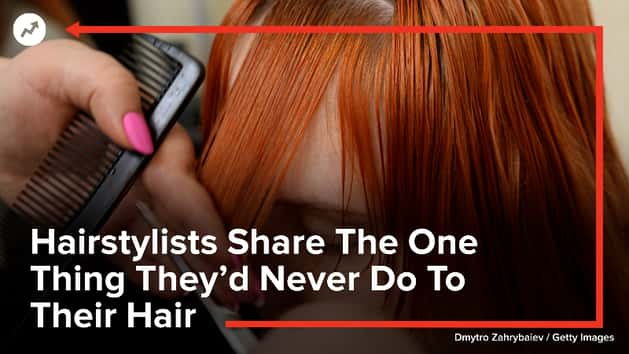


Hair care is more complicated than you might think — it seems there’s always something to learn or another myth that needs busting. So what’s true and what’s not? We recently asked hairstylists to share the common myths that drive them crazy.
Myth 1: Plucking out gray hair will cause more gray hair to grow.
This idea has been around for a while, but that doesn’t make it right. Here’s the truth: Whether you will have gray hair largely depends on whether your parents and grandparents did (not to mention, several different forms of stress that can contributor to graying).
“Gray or white hair is caused by the lack of melanin produced in the follicle of the hair, and this is genetics,” said William Whatley, celebrity hairstylist and creative education director for Scruple.
Friendly reminder: If gray hair is in your genetics, that’s OK — gray hair can look great!
Myth 2: The more suds in a shampoo, the better the product.
There’s something aesthetically pleasing about sudsy soap, but that doesn’t mean it’s better for your hair. In fact, it could mean the opposite.
“Sometimes, the more suds in a product, the more harsh detergents and quaternary ingredients are in the product,” said Drew Hudson, a hairstylist at Salon 1905 in Gulfport, Mississippi, and an educator for the hair care brand Pure Brazilian. “Harsh detergents and quaternaries will strip the natural oils needed to maintain healthy hair and scalp, and are also harsh on color-treated hair.”
Rather, he suggested a low-sulfate or sulfate-free shampoo.
Myth 3: It’s cheaper to get a trim.
That would be nice, wouldn’t it?
“My favorite myth is when clients ask if they just get a trim, does it cost less,” said Katelyn Ellsworth, a natural color and extension specialist and founder of The Roslyn salon in San Diego. “Just because I’m cutting off less inches doesn’t mean I have to do any less work than if I was cutting off 6 inches.”
Myth 4: You can fix split ends with the right product.
Unfortunately, no matter what the bottle says, this myth is just that: a myth. (In fact, we have an entire article about it.)
“Split end repair products might give the appearance of a temporary repair by smoothing and sealing the hair shaft,” Hudson said. “[But] split ends technically cannot be ‘repaired.’”
To remove split ends, Hudson recommended getting a haircut.

Myth 5: Cutting your hair with your head upside-down leads to a perfectly layered haircut.
Many of us have felt the urge to cut our own hair to save money, right? If cutting it upside-down leads to a cute layered cut (since the hair in the front would be shorter than the hair pulled all the way from the back), why not?
Ellsworth warned against this, saying it’s not that easy. “Everyone’s hair is unique and so is their haircut,” she added. “There are a lot of social media hacks out there, but AI can’t take over this one!”
Myth 6: Cutting your hair makes it grow faster.
While it’s true that getting your hair cut every eight to 12 weeks keeps it healthy (which can help promote growth), getting a cut isn’t the trick for getting longer hair more quickly.
After all, hair can grow only so fast. “The normal rate of hair growth is about 6 inches a year on average,” Whatley said.
Certain supplements, topicals and light therapy are a few things that can actually help your hair grow, but keep in mind that some people will never be able to grow long hair because it’s not in their genetics.
Myth 7: Huge color transformations can happen in hours.
A hair transformation on an Instagram reel may look quick, but that’s not always the case — or the best bet.
“Going from black to blond [for example] is a marathon, not a sprint, if you want to keep your hair,” Ellsworth said. “In all reality, this may have taken two years.”
Small color enhancements can be done in a couple of hours, yes, but major changes — like going from super dark to super light hair — are a slower process. “[It] will take some time and take multiple color appointments to show an overall progression over time to achieve the end, desired look,” Ellsworth said.
Myth 8: There’s something influencers aren’t telling you.
Similar to how color transformations can take longer than they look, recreating a certain style isn’t as easy as an Instagram post may have you believe. Ellsworth speaks to how influencers may not share that they have extensions, for example, so sometimes clients will think a quick color and blowout will give them the same look.
“Why do we have to be the heartbreaker and tell them no matter what, it’s not going to look like that until they spend thousands of dollars?” she asked.
Myth 9: Dry shampoo can extend the time between shampoos indefinitely.
When you’re short on time or your hair randomly looks greasy, having some dry shampoo to massage in is such a lifesaver. Plus, hairstylists don’t think it’s inherently a “bad” thing.
With that said, dry shampoo also has its time and place.
“Using too much dry shampoo over an extended period of time can be a bad thing,” Hudson said. “Dry shampoos can cause product buildup and also clog pores on your scalp, which can lead to weakening the hair, causing hair breakage and also scalp irritation.”
So feel free to use dry shampoo, he said, just not every day. Continue to shampoo every few days or so, depending on what your hair and scalp require.
Perhaps most of all, remember to do what your hairstylist suggests. They know your hair almost as well, or maybe even better, than you do.

